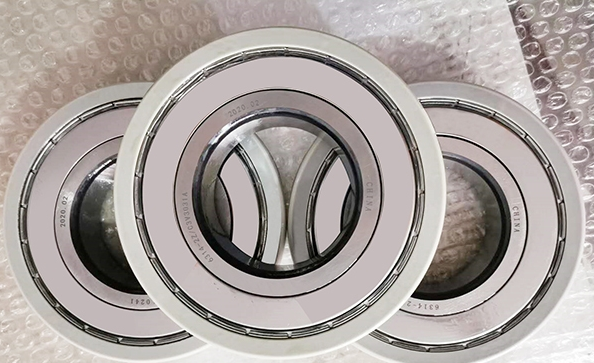

In electric motors and generators, there are loops and induced currents between the body, bogie and axles. When current flows through the bearing as it rotates, it breaks through the ultra-thin oil film at the rolling contact, creating sparks that cause localized melt damage to the contact surfaces and lead to galvanic corrosion. This can lead to poor bearing rotation, which can develop into spalling in severe cases, leading to bearing failure. In addition, the hardness of the rolling surface is reduced, making it easier to wear. This directly affects the performance and life of the motor and host. Therefore, it is necessary to develop insulating bearings suitable for electric motors and generators. The insulated bearing solves the problem of electrical corrosion of the bearing through the conductive path of the insulated bearing. Today, three types of insulated bearings are commonly used. ': (1) Spray ceramic coating on the outer ring of the bearing; (2) Spray resin on the outer ring of the bearing; (3) Components for ceramic rolling. Next, we mainly investigate the fabrication of insulated bearings with ceramic spray on the surface using the plasma spray technique and their detection methods.
A plasma sprayer is a complex system of equipment consisting of several individual devices and devices (2). It is mainly composed of power control system, spray gun, cooling system, air supply device, powder supply device, spray gun motion control device, spray parts motion control device, ventilation and exhaust device, dust collector, etc. Plasma spraying technology has the advantages of high deposition rate, high production efficiency and wide application range. It also maintains its position among various thermal spray methods, accounting for 50% of the thermal spray market. Plasma spray is ignited between the anode and cathode, creating a high-frequency arc. A gas (such as helium, hydrogen, nitrogen, or a mixture thereof) flows between the ionized electrodes and creates a plasma flame several centimeters long. The spraying material is sprayed from the spray gun to the plasma flame in powder form, heated and melted, and finally sprayed at high speed by compressed gas, colliding with the surface of the substrate to form a coating. The plasma arc temperature can reach 10,000 or more, and the flow velocity can reach 1,000 m/s or more. The resulting coatings have good quality, low porosity and strong adhesion to the substrate.
Plasma spraying can be applied to a wide variety of materials, including almost all solid-state ceramics, cermets, intermetallics, other inorganic non-metallic materials such as glass and slag, and various composite powders.
Al2O3 ceramics have high dielectric constant, high volume resistivity, low dielectric loss, high thermal shock resistance and all the excellent properties of insulating materials for electronic devices. In addition, the Al2O3 coating has excellent wear resistance, heat resistance and corrosion resistance. Therefore, Al2O3 is used as a coating material for insulating bearings. In addition, the addition of titanium dioxide to the coating improves the toughness and cohesion of the coating, but reduces the purity of the Al2O3 and the coating, resulting in reduced electrical insulation. Therefore, it is necessary to select a suitable formula according to the characteristics of the product. In this paper, pure Al2O3 powder is chosen as the spray material. The coating efficiency is high, but the porosity increases when the particle size of the spray powder is large and high power is required. The powder has the advantages of fine particle size, rapid heating, complete melting and high density coating, but low deposition efficiency and bond strength. Ceramic materials generally have high melting points and low thermal conductivity, so the particle size of thermal spray materials must be reduced. A suitable particle size range is usually 15-45 microns, and the powder particle size should account for a certain percentage. Improve deposition efficiency and coating density.
Process flow

The basic processing technology of insulated bearings is bearing/sample processing - precision measurement - plate processing - primer spraying ceramic coating spraying - sealing processing - grinding.
According to the performance test standard, the sample block size is: cylindrical sample 25mm 40mm, disc sample 52mm 4mm, the cylindrical sample is mainly used for coating adhesion test (Figure 1), and the disk sample is mainly used for microhardness test. This test bearing uses a 7212 angular contact ball bearing (GCr15) and is coated with Al2O3 on the outer ring outer diameter surface, inner diameter surface and inner ring end face. The coating performance requirements are thickness 0.25-0.3 mm, breaking strength greater than 1000 V/AC, insulation resistance greater than 50 MO and coating bond strength greater than 20 MPa. Adopt advanced GP-80 high-energy plasma spraying device. The spraying process is as follows:
(1) Matrix pretreatment. Pretreatment of metal substrates includes cleaning and decontamination, shielding, sandblasting and roughening, and substrate preheating. First clean the bearing rings with organic solvents such as steam and oil, and cover the unsprayed surface of the bearing with tape; roughen the surface of the corundum abrasive to be sprayed with a sandblaster to expose the new active surface of the metal matrix and increase the spray particles Mechanical intercalation with the substrate; the substrate is then preheated to reduce the temperature gradient between the jetted drop and the substrate and reduce thermal stress.
(2) Spraying.
(3) Select fixtures and tools according to the shape and size of the substrate. The plasma gas is N2 and H2, the spraying current is 500 A (DC), the voltage is 74 ~ 80 kV, and the powder feeding speed is 3 kg/h, which matches the power of the plasma flame flow. The spraying distance is about 50~100 mm, and the spraying angle is as close to 90 as possible. During the spraying process, the substrate temperature is controlled by multiple spraying, and the coating thickness is controlled by multiple measurements.
Hot information

